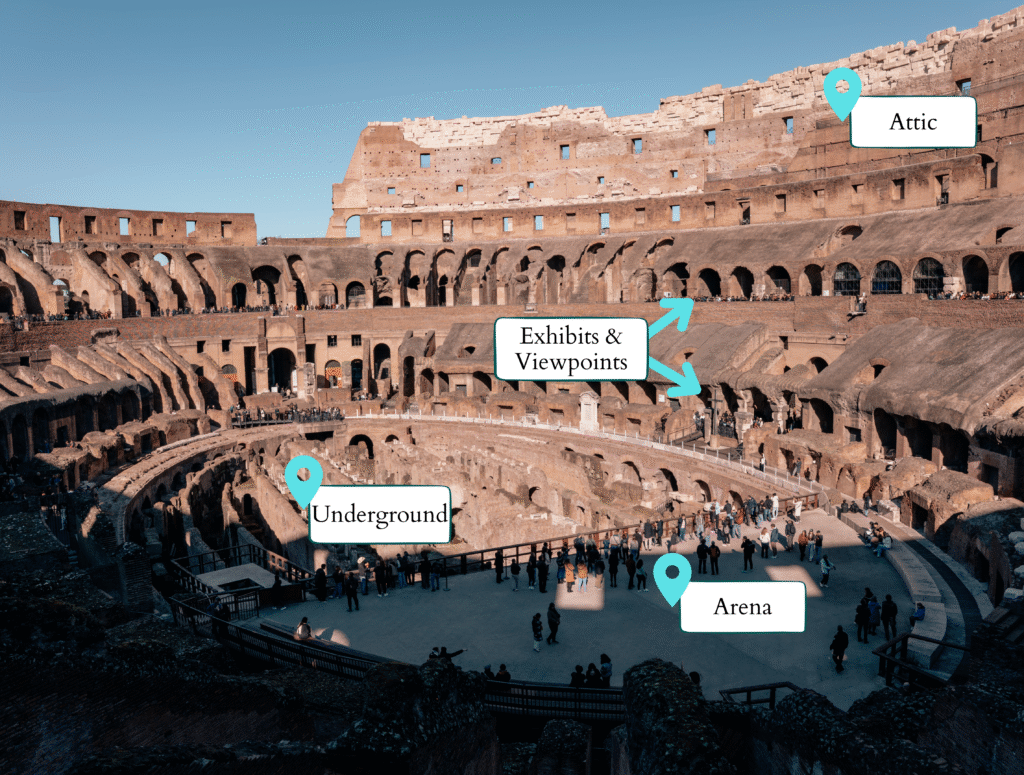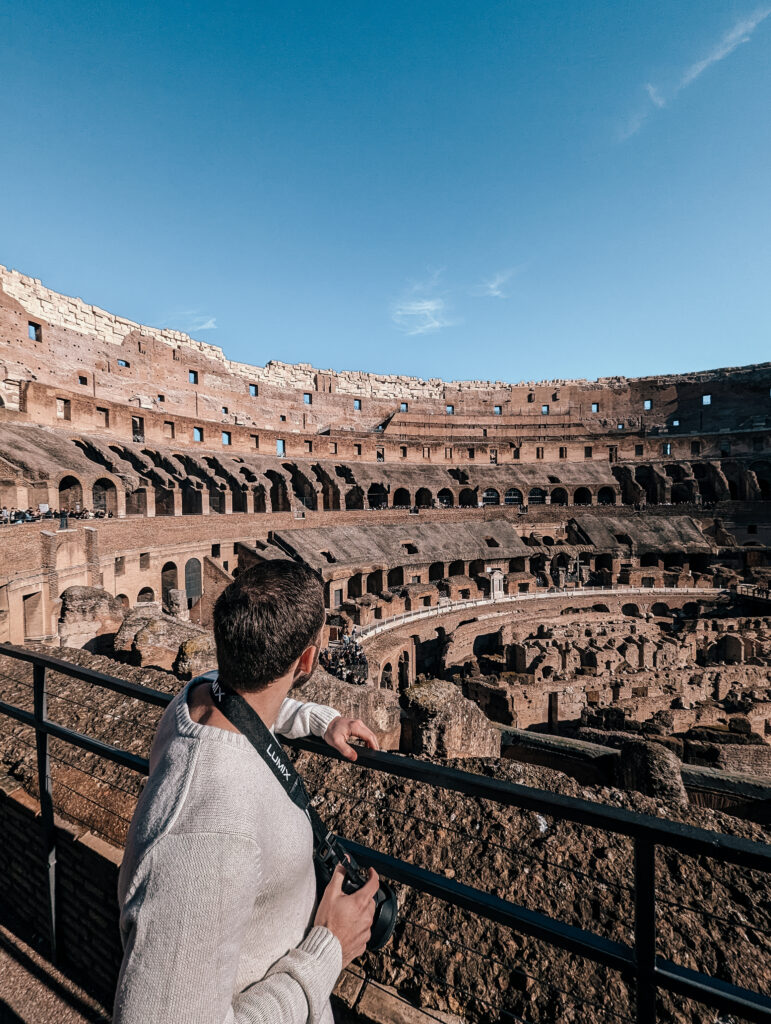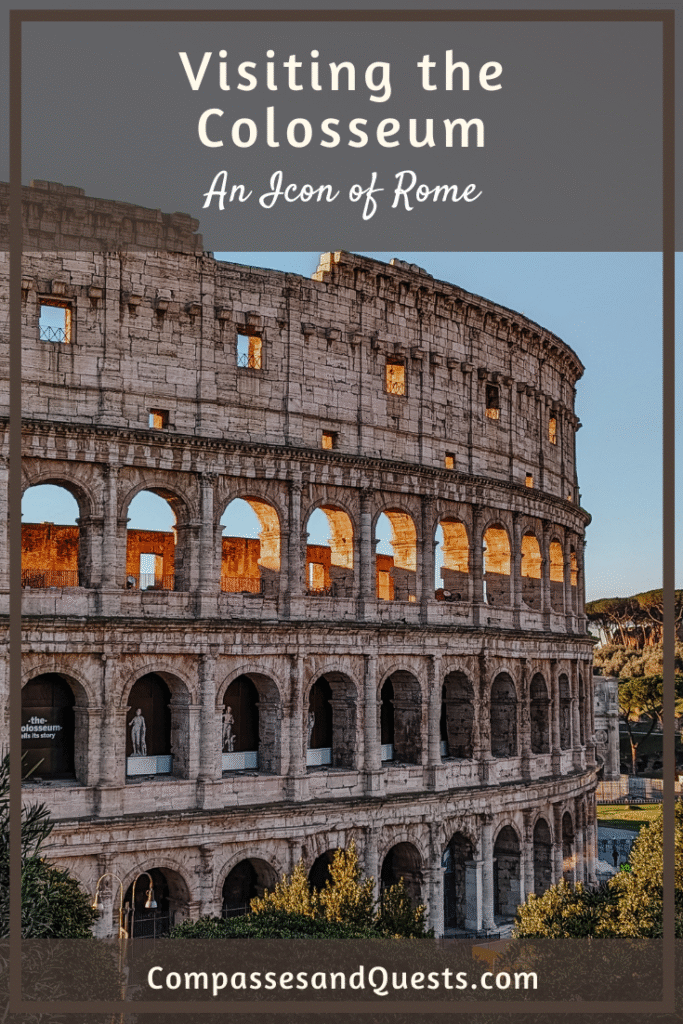Roman architecture is nothing short of incredible, and the Colosseum is one of the most iconic structures remaining from that era. When visiting Rome, we’d say a stop at the Colosseum is a must! It is one of the most popular attractions in the city though, so a bit of preparation is necessary if you want to go inside this famous building. Below we’ll provide some tips for visitors.

Some Colosseum History
The Colosseum, or Flavian Amphitheater, was constructed beginning sometime around 70 CE under Flavian rulers. In 80 CE, Titus dedicated the amphitheater in a large celebration with 100 days of games. Over the years, thousands of performances took place here, from gladiator battles to animal hunts. Gladiators were generally slaves, prisoners of war, and criminals.
In the 430s CE, gladiator games were abolished. The amphitheater was then used as a fortress and even a church. Earthquakes and other events damaged the structure over time, and it fell into a state of neglect. Materials from the building were taken to build other structures in Rome, including St. Peter’s Basilica.
In the 18th century, prominent figures in Rome called for the preservation of the Colosseum, which had mostly fallen into ruin. Only in the 1990s did a major restoration take place. Today, it is an incredibly popular tourist attraction, drawing in around 7 million visitors annually!

Getting to the Colosseum
The Colosseum is located in the heart of Rome with many restaurants, hotels, and other attractions nearby, so it is common to reach it on foot.
If coming from further away, there are many public transport options to get you to the Colosseum. The Colosseo metro station, which is served by Line B, is just nearby. You can also take buses 51, 75, 81, 85, 87, 117, or 118, all of which stop just outside the Colosseum. Lastly, tram Line 3 also stops just outside. For more info on routes and schedules, visit the transport website.
If you happen to be driving, there are some paid parking garages nearby, like Park Services Colosseum or Garage Park Colosseo. There are also parallel spots in the streets around the Colosseum. Note that it can get very busy in the area and street parking can be hard to come by. Make sure you follow all regulatory signs or you will be fined.
You could also take a taxi to the Colosseum. There are various taxi stands around the city, or you can download apps like FreeNow or itTaxi to call a ride. There is also Uber, but it is not as common, and they supposedly have a partnership with taxi companies, so you may be sent a taxi anyway unless you pay extra for other Uber services, like Uber Lux. We didn’t use any taxis or rideshares while in Rome because the public transit was great, so we aren’t totally familiar with that mode of transport here.

Tickets and Fees
There are various tickets that grant visitors access to different areas of the Colosseum – the Attic, Underground, Arena, and other Colosseum levels.
Standard Ticket (Colosseum, Forum, Palatine): €18
- Grants access to the Colosseum exhibits and main levels, the Roman Forum, and Palatine Hill – not including SUPER Sites. Ticket is valid for single access to each site over a 24hr period.
- Must book a time slot for Colosseum entry.
- Tickets released 30 days in advance.
- Maximum permitted Colosseum visiting time: 1hr 15min.
Only Arena: €18
- Grants access to the Arena of the Colosseum only, the Roman Forum, and Palatine Hill – including SUPER Sites. This is a good option if other tickets are sold out, you are short on time, or you aren’t interested in walking through the exhibits in the Colosseum. Ticket is valid for single access to each site over a 24hr period.
- Must book a time slot for Arena entry.
- Tickets released 30 days in advance.
- Maximum permitted Arena visiting time: 20min.
Full Experience Ticket with Arena: €24
- Grants access to the Colosseum exhibits and main levels, Arena, the Roman Forum, and Palatine Hill – including SUPER Sites. Ticket is valid for single access to each site over two consecutive days.
- Must book a time slot for Colosseum entry.
- Tickets released 7 days in advance.
- Maximum permitted Colosseum visiting time: 1hr 30min.
Full Experience Ticket with Underground: €24
- Grants access to the Colosseum exhibits and main levels, Underground, Arena, the Roman Forum, and Palatine Hill – including SUPER Sites. Ticket is valid for single access to each site over two consecutive days.
- Must book a time slot for Underground entry. This option has very limited tickets! This is the ticket option we chose and, even during off-season in February, tickets were sold out by the time we finished filling out the booking info.
- Tickets released 30 days in advance.
- Maximum permitted Colosseum visiting time: 1hr 30min.
Full Experience Ticket with Attic: €24
- Grants access to the Colosseum exhibits and main levels, Attic (upper levels), the Roman Forum, and Palatine Hill – including SUPER Sites. Ticket is valid for single access to each site over two consecutive days.
- Must book a time slot for Attic entry. This option has very limited tickets!
- Tickets released 30 days in advance.
- Maximum permitted Colosseum visiting time: 1hr 30min.

Tickets are released every 15 minutes generally 30 days in advance of the time slot. For example, we wanted to visit the Underground area of the Colosseum on February 14th at 8:45am, so tickets for that slot were released on January 15th at 8:45am local time in Rome. These sell frequently within seconds, so we booked at 12:45am our time since we’re 8 hours behind.
There are also Night at the Colosseum tours and other events and tickets available. For more info on tickets and discounted rates, visit the official website. You can buy tickets from the ticket office upon arrival and enter during the next available time slot; however, we’d recommend buying them online in advance to avoid ticketing lines and so your entry is guaranteed.
Entrance to the Colosseum is free on the first Sunday of each month. There is no access to the Arena or Attic on these days. There are no time slot bookings on these days so tickets are given upon arrival based on availability.

City Passes
The Roma Pass covers the standard entrance completely or at a discounted rate, depending on the number of covered sites you have visited. You still must book a time slot. Select the standard 24h Colosseum, Forum, and Palatine ticket and follow the link where it says “for holders of the Rome Pass, view if available here.” You can then reserve your time slot and select the free or discounted option.
Other passes, like the Rome City Pass via Turbopass, the Rome Tourist Card, and the GoCity Pass, also cover entry to the Colosseum but will require you to book your slot via another website.

Hours & Regulations
The Colosseum is open:
- January 2nd to February 28th from 8:30am – 4:30pm with last entry at 3:30pm
- March 1st to March 29th from 8:30am – 5:30pm with last entry at 4:30pm
- March 30th to September 30th from 8:30am – 7:15pm with last entry at 6:15pm
- October 1st to October 25th from 8:30am – 6:30pm with last entry at 5:30pm
- October 26th to December 31st from 8:30am – 4:30pm with last entry at 3:30pm
Hours are subject to change and may vary on holidays. Check the website for the latest updates.
Pay attention to the instructions when booking your ticket. There will be information on which access point to enter through and how early you need to show up. You will need to present a valid ID that matches the name on the ticket.
When entering the Colosseum, you will pass through security. Visitors cannot bring in large backpacks or bags. You also cannot bring in aerosols, glass containers, food and drink other than water, or sharp objects. There are no lockers here. We’ve seen mixed things about regulations on water bottles. Per some suggestions, we brought an empty clear bottle and filled it once inside.
This regulation should go without saying, but do not deface or damage any part of the Colosseum. In recent years, there have been a handful of people caught vandalizing this historic structure. It’s not cute or fun to carve your initials on, spray paint, or take pieces from historic sites. Don’t be that person.

Our Colosseum Visit
It was our second day in Rome and we eagerly headed out from our hotel to the Colosseum with the goal of arriving just around sunrise. Being there in February, that luckily meant that sunrise wasn’t brutally early. We stood along the railing in the Monte Oppio garden just above the Colosseum, watching as the warm morning sun lit up the arches of this magnificent ancient structure. After enjoying the view from there for a bit, we walked down the steps to the Colosseum.
We admired Constantine Arch and strolled around the outside of the Colosseum. A bit before the Colosseum opened, a line began to form, so we headed over and queued. They checked the time on our ticket and motioned us forward.


Underground & Arena
Upon passing through security, we were directed to the meeting place for the Underground. Even if you don’t book a guided tour, the visits to the Colosseum Underground are still accompanied.

The Underground is a network of tunnels and chambers where gladiators, animals, and weaponry were once held and transported before events. There used to be various trap doors and pulley systems that were used to move people and animals up to the arena. We had an audio guide we were instructed to download on our phone that provided some info as we moved through the underground with our group. When I first visited the Colosseum with my family as a kid, the Underground wasn’t open to the public, so it was cool to be able to see it on this trip.


After making our way through the underground, our accompanied visit ended at the Arena. Much of the Arena floor has collapsed and no longer exists, but a portion has been reconstructed. Standing in the Arena gives you a little perspective into what it would have been like to enter the amphitheater as a gladiator.

The Colosseum Museum
After exploring the Colosseum Underground and Arena, we headed into the tiers of the Colosseum. Here, there are various exhibits covering the history of the Colosseum, providing a glimpse into life in Roman times, and displaying various artifacts. Though we were there early in the morning during off season, the exhibit areas got very crowded quickly.
While wandering the couple levels included in our ticket, we also got some great views from the terraces overlooking the rest of the Colosseum and Arena below. We imagine these views would be even more incredible if you had tickets to access the highest levels of the Attic! We admired this amazing piece of history a bit longer before making our way to the exit. Next up: the Roman Forum and Palatine Hill!


Tours
If you’d like a more structured visit and a tailored look into the history of the Colosseum, a tour is a great option. While more expensive than just the entry ticket, booking a tour may also be an option to consider if tickets are sold out. Some tours that enter the Colosseum may still have spaces available and can get you inside.
There are various tours available to be booked through the Colosseum website, but there are also other options offered by individual operators. Many of these can be found online through individual tour company sites or sites like Get Your Guide and Viator.
Like this Post? Pin it!




